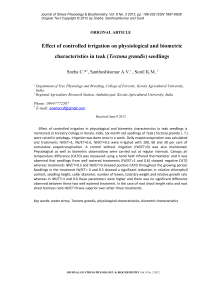Effect of controlled irrigation on physiological and biometric characteristics in teak (Tectona grandis) seedlings
Автор: Sneha C., Santhoshkumar A.V., Sunil K.M.
Журнал: Журнал стресс-физиологии и биохимии @jspb
Статья в выпуске: 3 т.8, 2012 года.
Бесплатный доступ
Effect of controlled irrigation in physiological and biometric characteristics in teak seedlings is monitored at Forestry College in Kerala, India. Six month old seedlings of Teak (Tectona grandis L. f.) were raised in polybags. Irrigation was done once in a week. Daily evapotranspiration was calculated and treatments IW/ET=1, IW/ET=0.6, IW/ET=0.3 were irrigated with 100, 60 and 30 per cent of cumulative evapotranspiration. A control without irrigation (IW/ET=0) was also maintained. Physiological as well as biometric observations were carried out at regular intervals. Canopy air temperature difference (CATD) was measured using a hand held infrared thermometer and it was observed that seedlings from well watered treatments (IW/ET=1 and 0.6) showed negative CATD whereas treatments IW/ET=0.3 and IW/ET=0 showed positive CATD throughout the growing period. Seedlings in the treatment IW/ET= 0 and 0.3 showed a significant reduction in relative chlorophyll content, seedling height, collar diameter, number of leaves, total dry weight and relative growth rate whereas in IW/ET=1 and 0.6 these parameters were higher and there was no significant difference observed between these two well watered treatment. In the case of root shoot length ratio and root shoot biomass ratio IW/ET=0 was superior over other three treatments.
Water stress, tectona grandis, physiological characteristics, biometric characteristics
Короткий адрес: https://sciup.org/14323663
IDR: 14323663
Текст научной статьи Effect of controlled irrigation on physiological and biometric characteristics in teak (Tectona grandis) seedlings
Water comprises 70 to 85 per cent of the fresh weight of most of the plants. It is a means and medium of transportation for food materials within the plant. It has been estimated that a leaf will exchange up to 100 per cent of its water in a single hour on a warm, dry, sunny day and an amount equivalent to 100 times of its fresh weight during the whole lifetime (Taiz and Zeiger 2006). When plants loss more water from the aerial part, than they can replace via root uptake they exhibit water deficit, which can induce wilting, damage to cell membranes and ultimately, cell death. Plant water deficit can also impair cell division, plant growth, photosynthesis, respiration, and other physiological processes (Kozlowski et al., 1991). Drought limits plant growth and field crops production more than any other environmental stresses (Zhu 2002). Thus water limitation may prove to be a critical constraint to primary productivity under future scenarios of more arid climates due to global environmental change (Fischer et al., 2001).
The effects of water stress in the growth and development of forest trees is described by many authors (James and Bell 2000; White et al. , 2000; Burgess et al. , 2001 etc.). Effect of water stress is more deleterious when trees are in its early stages of growth. Tremendous seedling mortality occurs annually during initial stages of seedling establishment because of recurrent and periodic or sustained internal water deficit (Kozlowski 1968).
Teak is one of the most important timber species that are widely used for raising plantations and afforestation purposes in India. It requires a relatively long nursery period lasting about one year. However, the species is still poorly studied in relation to its management in plantations and its physiological responses to environmental stresses. Standardization of nursery techniques is necessary for any afforestation programme as expenditure on nursery takes itself a major portion of plantation cost. The cost can however, be reduced by evolving suitable and desired nursery practices on scientific lines (Bahuguna and Lal 1992). Determination of optimal watering frequency and water requirement for teak seedlings is very essential. Hence the present study is oriented to study the effect of controlled irrigation in physiological and biometric characteristics in seedlings of teak.
MATERIALS AND METHODS
The experiment was carried out at College of Forestry, Kerala, India (10° 31'N latitude and 76° 13'E longitude with an elevation of about 22m above mean sea level) during 2010-2011. The study
198 area enjoys a warm humid tropical climate with distinct summer and rainy season. It had received a total rainfall of 3018.4 mm during 2010 and 87.5 mm till the end of March in 2011.
Six months old seedlings of teak were raised in polythene bags and grown under a rainout shelter. Irrigation was provided once in every seven days. Daily evapotranspiration was calculated and treatments IW/ET=1, IW/ET=0.6, IW/ET=0.3 and IW/ET=0 were irrigated with 100, 60, 30 and 0 per cent of cumulative evapotranspiration calculated on daily basis using FAO modified Penman's equation (Allen et al. , 1998).
The plants were evaluated each week in order to measure the effect of water stress in chlorophyll content using chlorophyll meter (SPAD-502, Minolta). Randomly selected ten mature leaves were used for this purpose. Relative growth rate was also estimated. Five plants were randomly taken out from each treatment combination biweekly beginning at 14 days after start of treatment and continued up to six months. Seedlings were destructively sampled. Stem, root and leaf portion were separated. Observations on height, collar diameter, number of leaves, root length, root shoot length ratio and root shoot biomass ratio were taken. Data obtained were subjected to statistical analysis using SPSS (v 17).
RESULTS AND DISCUSSION
Chlorophyll content
Chlorophyll content was found to be minimum in non-irrigated IW/ET=0 followed by treatment IW/ET=0.3 (Figure 1). Treatment IW/ET=0 showed 17 per cent reduction and in IW/ET=0.3, the reduction was 8 per cent in relative chlorophyll content. In well watered treatments IW/ET=1 and IW/ET=0.6 it was higher and were on par. Severe drought causes rupture of chloroplast and disintegration of chlorophyll molecules. Decreased or unchanged chlorophyll level during drought stress has been reported in many species, depending on the duration and severity of drought (Beltrano and Ronco 2008; Nikolaeva et al., 2010). Many of the existing reports suggest that mild stress will not affect chlorophyll content (Manes et al., 2001; Duan et al., 2005; and Yanbao et al., 2006). So it can be assumed that irrigation at IW/ET=0.3 impose severe stress in teak seedlings to impart chlorophyll content.
Height
From the height data it has been observed that seedlings from treatments IW/ET=1 and IW/ET=0.6 had showed more height compared to other two treatments (Figure 2). In IW/ET=0 and IW/ET=0.3, seedling height was less. This indicates irrigation at level IW/ET=0.3 was not enough to provide sufficient water supply for the growth of seedlings. When evaporation exceeds water supply, it creates drought stress which is characterized by the reduction of cell water content, diminished leaf water potential and turgor loss, closure of stomata and decrease in cell enlargement and growth. Many reports suggest the negative impact of water stress in plant growth (Anjum et al. , 2003; Bhatt and Rao 2005; Kusaka et al. , 2005; Shao et al. , 2008). It has been also observed that in severe water stressed seedlings of treatments IW/ET=0 and IW/ET=0.3 had allocated more biomass towards roots than to shoots.
Collar diameter
Water stress in seedlings caused reduction in collar diameter. It varied from 8.5 mm in well watered IW/ET=1 to 6.6 mm in treatment IW/ET=0. The observation on collar diameter was given in Figure 3. Collar diameter was maximum in treatment IW/ET=1. This might be due to more availability of water. In treatments IW/ET=0.3 and 0, water stress might influence the physiological processes and may result in poor performance of seedlings. It is known that high soil water availability facilitate nutrient accumulation, leaf growth, leaf area and number of leaves which converted more solar energy and fixed more CO2 to produce more photosynthates, and thus greater growth and biomass production (Ceulemans et al., 1993). Sufficient soil water availability higher irrigation probably maintained cell turgidity and increased in leaf size and the overall biomass (Souch and Stephens 1998).
Number of leaves
Severely water stressed teak seedlings (IW/ET=0 and IW/ET=0.3) showed a significant reduction in number of leaves from the second fortnight of treatment (Figure 3). Number of leaves in seedlings of other two treatments (irrigation at IW/ET=1 and irrigation at IW/ET=0.6) was high and showed no significant variation among each other most of the time. Performance of IW/ET=0 and IW/ET=0.3 in terms of number of leaves were on par.
Root shoot length and biomass ratio
Teak seedlings of treatment IW/ET=0 was superior throughout the experimental period in terms of root shoot length and biomass ratio (Figure 4). No significant difference was observed among the other treatments. Root shoot ratio appears to be governed by a functional balance between water uptake by the root and photosynthesis by the shoot increased root growth. This functional balance is affected by water stress and more biomass is allocated towards roots to increase more water absorption.
Relative growth rate
Different levels of irrigation had significant effect on relative growth rate of teak seedlings
(Figure 5). It was more in well watered treatments (irrigation at IW/ET=1 and 0.6). For seedlings with irrigation at IW/ET=0.3 RGR was lower than well watered treatments. Non- watered IW/ET=0 seedlings showed minimum increase in growth.

Figure 1. Relative chlorophyll content (SPAD unit) in teak seedlings under different irrigation regimes
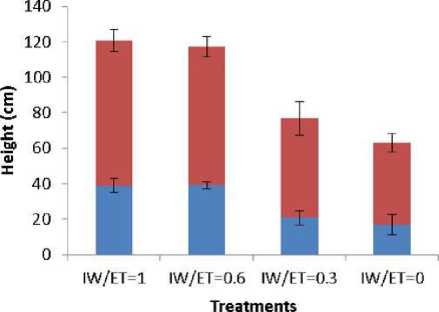
■ Total height
■ Shoot length
Figure 2. Height of teak seedlings under different irrigation regimes
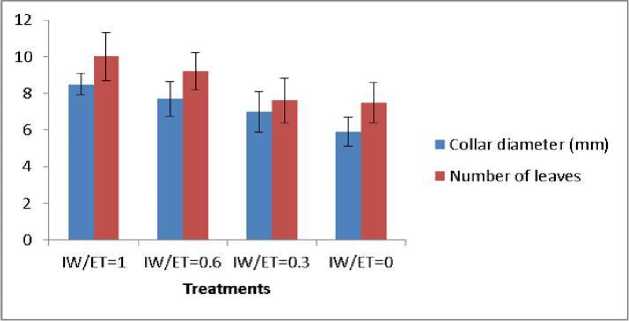
Figure 3. Collar diameter and number of leaves of teak seedlings under different irrigation regimes
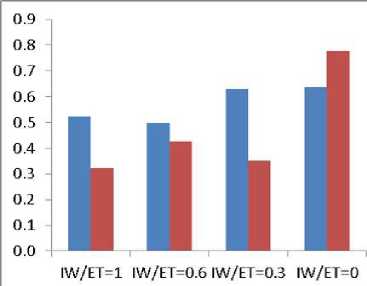
■ Root shoot length ratio
■ root shoot biomass ratio
Figure 4. Root shoot length and biomass ratio of teak seedlings under different irrigation regimes
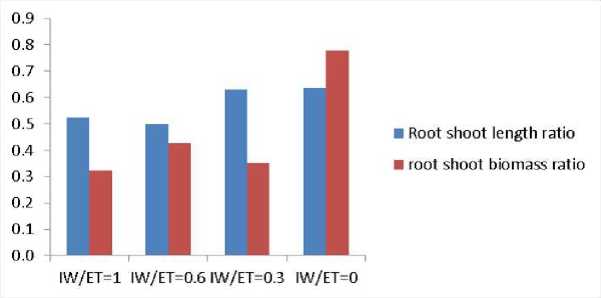
Figure 5. Relative growth rate of teak seedlings under different irrigation regimes
CONCLUSION
These results suggest that water stress cause reduction in growth and affect physiological parameters in teak. Irrigation at IW/ET=0.3 at weekly interval is not enough to meet the water requirement of seedlings whereas irrigation at the rate of IW/ET=0.6 is sufficient. It was also concluded that there is no added advantage if we provide irrigation at the rate of IW/ET=1.
Список литературы Effect of controlled irrigation on physiological and biometric characteristics in teak (Tectona grandis) seedlings
- Allen, R.G., Pereira, L.S., Raes, D. and Smith, M. (1998) Crop evapotranspiration. FAO Irrigation and Drainage Paper 56. FAO, Rome, 299p.
- Anjum, F., Yaseen, M., Rasul, E., Wahid, A., and Anjum, S. (2003) Water stress in barley (Hordeum vulgare L.). I. Effect on morphological characters. Pakistan J. Agric. Sci., 40: 43-44.
- Bahuguna, V.K. and Lal, P. (1992) Standardization of nursery techniques of Acacia auriculiformis A. Cum Ex Benth under North Indian mist climatic conditions. Part-1. Method of seed sowing and irrigation schedule. Indian For., 118 (9): 616-622.
- Beltrano, J. and Ronco, M.G. (2008) Improved tolerance of wheat plants (Triticum aestivum L.) to drought stress and rewatering by the arbuscular mycorrhizal fungus Glomus claroideum: Effect on growth and cell membrane stability. Brazilian J. Plant Physiol., 20: 29-37.
- Bhatt, R.M. and Rao, N.K.S. (2005) Influence of pod load response of okra to water stress. Indian J. Plant Physiol., 10: 54-59.
- Burgess, S.S.O., Adams, M.A., Turner, N.C., White, D.A., and Ong, C.K. (2001) Tree roots: conduits for deep recharge of soil water. Oecologia, 126: 158-165.
- Ceulemans, R.J., Pontailler, F.M., and Guittet, J. (1993) Leaf allometry in young poplar stands: reliability of leaf area index estimation, site and clone effects. Biomass Bioenerg., 4: 769-776.
- Duan, B., Lu, Y., Yin, C., Junttila, O., and Li, C. (2005) Physiological responses to drought and shade in two contrasting Picea asperata populations. Physiol. Plant., 124: 476-484.
- Fischer, G., Shah, M., Velthuizen, H., and Nachtergaele, F.O. (2001) Global agro‐ecological assessment for agriculture in the 21st century. IIASA and FAO, Laxenburg, Austria.
- James, S.A. and Bell, D.T. (2000) Leaf orientation, light interception and stomatal conductance of Eucalyptus globulus ssp. Globulus leaves. Tree Physiol., 20: 815-823.
- Kozlowski, T.T. (ed.). 1968. Water Deficits and Plant Growth, Vol. I. Academic Press, New York, 336p.
- Kozlowski, T.T., Kramer, P.J., and Pallardy, S.G. (1991) The Physiological Ecology of Woody Plants. Academic Press, USA, 657p.
- Kusaka, M., Ohta, M. and Fujimura, T. (2005) Contribution of inorganic components to osmotic adjustment and leaf folding for drought tolerance in pearl millet. Physiol. Plant., 125: 474-489.
- Manes, F., Donato, E., and Vitale, M. (2001) Physiological response of Pinus halepensis needles under ozone and water stress conditions. Physiol. Plant., 113: 249-257.
- Nikolaeva, M.K., Maevskaya, S.N., Shugaev, A.G., and Bukhov, N.G. (2010) Effect of drought on chlorophyll content and antioxidant enzyme activities in leaves of three wheat cultivars varying in productivity. Russian J. Plant Physiol., 57: 87-95.
- Shao, H.B., Chu, L.Y. Shao, M.A., Jaleel C.A., and Hong-Mei, M. (2008) Higher plant antioxidants and redox signaling under environmental stresses. Comptes Rendus Soc. de Biol., 331: 433-441.
- Souch, C.A. and Stephens, W. (1998) Growth, productivity and water use in three hybrid poplar clones. Tree Physiol., 18: 829-835.
- Taiz, L. and Zeiger, E. (eds.). (2006) Plant Physiology. Sinauer Associates, Inc., USA, 764p.
- White, D.A., Beadle, C.L., and Worledge, D. (2000) Control of transpiration in an irrigated Eucalyptus globulus Labill. plantation. Plant Cell Environ., 23: 123-134.
- Yanbao, L., Chunying, Y., and Chunyang, L. (2006) Differences in some morphological, physiological and biochemical responses to drought stress in two contrasting populations of Populus przewalski. Physiol. Plant., 127: 182-191.
- Zhu, J.K. (2002) Salt and drought stress signal transduction in plants. Ann. Rev. Plant Biol., 53: 247-273.

